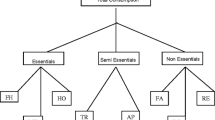Abstract
Previous research shows that consumers’ response to price and income changes is heterogeneous. In addition, evidence from national data often does not support the classical assumption of one commodity-one price. This paper introduces a data coherent generalization to the quadratic form of the almost ideal demand system (g-QUAIDS) that incorporates the sources of heterogeneity in the demand function and allows for regional price variation. Aggregation over consumers imposes a linearization to the g-QUAIDS that requires a new set of price indices. The results from an empirical study by using microdata from the Household Income and Expenditure Survey of Iran highlight the impact of aggregation bias in relation to the level of aggregation. An investigation of the predictive power of linear versus nonlinear g-QUAIDS in different aggregation levels provides practical recommendations for consumer demand analysis.





Similar content being viewed by others
Notes
One possible commodity group price index for individual consumers is Stone–Lewbel (SL) index (see Hoderlein and Mihaleva 2008).
Notice the similarity of \(\ln P_j \) with Stone price index. The difference is that aggregation in Stone index is over commodities.
The complete lists of elasticities and parameter estimates of the model are available on request.
References
Alston JM, Chalfant JA, Piggott NE (2001) Incorporating demand shifters in the almost ideal demand system. Econ Lett 70:73–78
Attanasio O, Frayne C (2006) Do the poor pay more? Eighth BREAD conference on development economics. Bureau for Research and Economic Analysis of Development, Ithaca, New York
Banks J, Blundell R, Lewbel A (1997) Quadratic Engel curves and consumer demand. Rev Econ Stat 79:527–539
Barten A (1964) Family composition prices and expenditure patterns. In: Hart P et al (eds) Econometric analysis for national economic planning, 16th symposium of the Colston Society. Butterworth, London
Blundell R, Kristensen D, Matzkin R (2014) Bounding quantile demand functions using revealed preference inequalities. J Econom 179(2):112–127
Blundell R, Pashardes P, Weber G (1993) What do we learn about consumer demand patterns from micro data? Am Econ Rev 83:570–597
Blundell R, Stoker TM (2005) Heterogeneity and aggregation. J Econ Lit 43:347–391
Deaton A (1997) The analysis of household surveys: a microeconometric approach to development policy. Johns Hopkins University Press, World Bank, Washington
Deaton A, Muellbauer J (1980) An almost ideal demand system. Am Econ Rev 70:312–326
Debreu G (1959) Theory of value: an axiomatic analysis of economic equilibrium. Wiley, New York
Denton FT, Mountain DC (2001) Income distribution and aggregation/disaggregation biases in the measurement of consumer demand elasticities. Econ Lett 73:21–28
Dette H, Hoderlein S, Neumayer N (2016) Testing multivariate economic restrictions using quantiles: the example of Slutsky negative semideniteness. J Econom 191(1):129–144
Engel E (1895) Die Lebenskosten Belgischer Arbeiter-Familien Früher and Jetzt. Int Stat Inst Bull 9:1–74
Gorman WM (1953) Community preference fields. Econometrica 21:63–80
Hoderlein S (2011) How many consumers are rational. J Econom 164(2):294–309
Hoderlein S, Mihaleva S (2008) Increasing the price variation in a repeated cross section. J Econom 147(2):316–325
Hoderlein S, Stoye J (2014) Revealed preferences in a heterogeneous population. Rev Econ Stat 96(2):197–213
Jorgenson DW, Lau LJ, Stoker TM (1980) Welfare comparisons under exact aggregation. Am Econ Rev 70:268–272
Lewbel A (1999) Consumer demand systems and household expenditure. In: Pesaran H, Mickens M (eds) Handbook of applied econometrics: Blackwell handbooks in economics. Blackwell Publishers, Oxford
Lewbel A, Pendakur K (2009) Tricks wth hicks: the EASI demand system. Am Econ Rev 99:827–863
Matsuda T (2006) Linear approximations to the quadratic almost ideal demand system. Empir Econ 31:663–675
McKelvey C (2011) Price, unit value, and quality demanded. J Dev Econ 95(2011):157–169
Moschini G (1995) Units of measurement and the stone index in demand system estimation. Am J Agric Econ 77:63–68
Muellbauer J (1976) Community preferences and the representative consumer. Econometrica 44:979–999
Prais SJ, Houthakker HS (1955) The analysis of family budgets. Cambridge University Press, Cambridge (2nd edition 1971)
Slesnick DT (2005) Prices and demand: new evidence from micro data. Econ Lett 89:269–274
Acknowledgments
I would like to thank the editor and two anonymous referees and Professor Atsushi Maki for their helpful comments. I am also grateful to Yanhong Zhang and Alan Cooper for proofreading the paper.
Author information
Authors and Affiliations
Corresponding author
Rights and permissions
About this article
Cite this article
Bidarbakht Nia, A. A generalization to QUAIDS. Empir Econ 52, 393–410 (2017). https://doi.org/10.1007/s00181-016-1082-8
Received:
Accepted:
Published:
Issue Date:
DOI: https://doi.org/10.1007/s00181-016-1082-8




